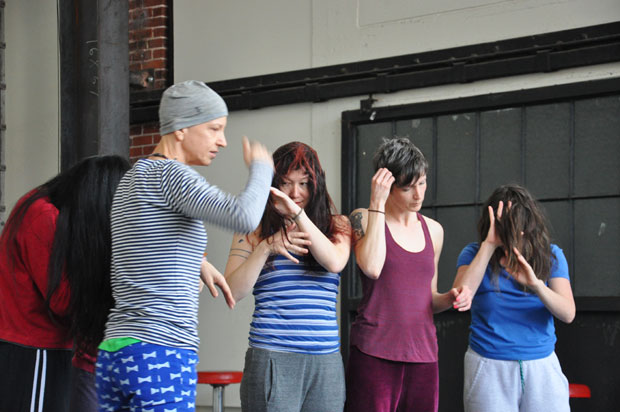
© Christy Funsch. (Click image for larger version)
Christy Funsch
Wrecking Dissolver – with Rowena Richie, Megan Nicely and Keith Hennessy
San Francisco, Joe Goode Annex
7 March 2015
www.funschdance.org
Going into an open rehearsal for Dissolver, San Francisco choreographer Christy Funsch’s new work, I had no idea what the piece was about. It’s a work in progress, so she may not know for sure yet, either; at any rate, she didn’t explain the 11-minute excerpt she showed in an open rehearsal on March 7 (the hour-long complete work will premiere in May at San Francisco’s ODC) in a spacious studio at the Joe Goode Annex.
Funsch is also not one to reveal intention in her gestural but abstract choreography; last year, for example, she and fellow dance artist Peiling Kao presented work at a private gallery, and we followed them from room to room as they danced in response to contemporary abstract paintings. The meanings were inscrutable, at least to me, but the experience was engrossing anyway.
That’s a not-uncommon reaction to contemporary choreography – “It was interesting, but what was it?” – and the feeling can deepen as you follow this branch of dance toward to the tip occupied by Funsch, Kao and other avant-garde artists. Coming from a classical ballet perspective, I confess too that it’s taken me several years to get my sea legs in the realm of performance stripped of story, symbolism, sometimes even music or familiar motion, and presented without helpful guideposts from the artist.
Appreciating this kind of dance is, for me, a practice in letting go: letting go of dependence on linear understanding, of attachment to “getting” an artist’s message and of the reassurance in being led through a piece to its conclusion. There is something liberating about allowing artists to kill the darlings of my thoughts.
Deconstructing Dance
A highly respected dance maker whose career recently passed its twenty-fifth year, Funsch is well aware of this side-effect of her genre. So rather than presenting the Dissolver excerpt in a typical open rehearsal, where the audience would watch Funsch work on it herself, she hosted a “Dance Wrecking.”
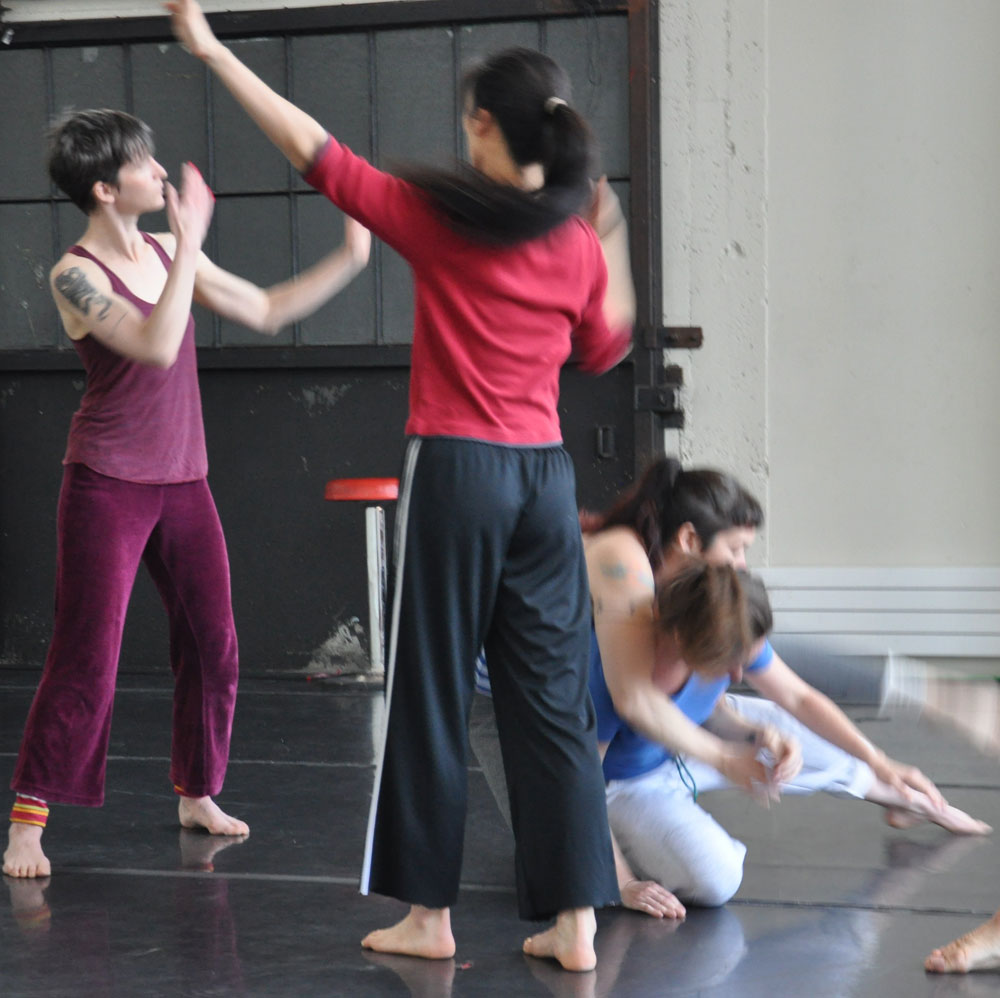
© Christy Funsch. (Click image for larger version)
Developed in 1995 by New York choreographer Susan Rethorst, Dance Wrecking entails inviting colleagues to view your in-progress work, then granting them freedom to “wreck” it – rearrange, reorder and/or recast the piece from their own artistic perspective, and then show the resulting new piece. Funsch’s goal for the day was twofold: generate embodied, rather than verbal, feedback as part of her creative process (the wreckers will be credited in the performance program for their contributions), and demystify that process for the audience of about thirty people, including fellow artists and curious civilians.
Through Wrecking, she says, “I learn what ‘works’ in the work. What are the places other people are drawn to? What are the places they forget about or edit out? Each time the dancers are asked to re-investigate the material, we get to a deeper place and understanding of it.”
Funsch chose Rowena Richie, Megan Nicely and Keith Hennessy as her wreckers. Close colleagues of Funsch’s, all three are well regarded in the city’s auteur choreography and performance-art world. The Bessie Award–winning Hennessy is the most widely known, perhaps especially for his 2008 work Crotch, which involved whips, stuffed animals, genitalia and lard; naturally, I was especially curious to see what he would do with Funsch’s much tamer raw material.
The trio had the option of viewing footage of the segment on Vimeo during the week prior. The Wrecking began at noon with a run-through of Funsch’s original excerpt, and then each artist in turn got 45–50 minutes to have their way with the work. Finally, all four versions were shown in order at 3 p.m. The only rules were Rethorst’s Wrecking parameters:
- Wreckers may not create new material, but may rearrange any of the existing material as much as they want.
- Wreckers do not have to use all of the material provided.
- All resulting material must be repeatable, rather than improvisational, with a strong directorial voice.
- No new cast members may be added, but existing members may be recast.
The Excerpt
Funsch’s ensemble passage, performed by Janet Das, Aura Fischbeck, Kao, Courtney Moreno and Erin Mei-Ling Stuart, set the baseline. (The full work, comprising duets and ensembles, will also include Chinchin Hsu and Phoenicia Pettyjohn.) Funsch has a taste for pedestrian movement and a keen eye for composition, so even though the dancers may be doing something as simple as shifting their weight, gazing at their hands or stomping their heels, they hang together in the manner of a Calder mobile.
Dissolver, or this segment of it, links discrete packets of movement with transitional steps that maneuver the dancers from one part of the performance space to another. Kao and Fischbeck lean toward each other in lunges while the other women wrap their arms around the pair’s legs; the formation breaks apart and into Kao and Murphy running sideways from corner to corner while the others move backward and forward between them. The group reassembles in a in a circle at the back of the space, walking slowly around with arms raised and rounded, tilting their torsos gently with each step.

© Christy Funsch. (Click image for larger version)
The group unites most memorably for an a cappella rendition of The Shangri-Las’ 1965 hit song “Out in the Streets,” sung by Das and accompanied by Stuart’s vocal rhythms and a movement assembly line that looks like a Steampunk cappuccino machine. The line hovers over Courtney Murphy folding and unfolding on the floor, then dissolves backwards into three women swimming across the floor with Stuart walking behind them, rowing her arms like a gondolier.
The construction could seem disjointed, but these are thoughtful and finely trained dancers who mirror each other’s intensity, intention and momentum, generating a natural flow through and between the phrases. And in spite of the cerebral nature of this type of dance, the overall effect of Dissolver is of sensuality and womanliness, and not only in the sections when the women put up and let down their long hair, hang it over their faces and running their fingers through it, and reach out to grasp each other’s hands.
The Wrecking
Each wrecker approached the material in a unique way, both in their working process and the value they placed on different movement phrases. In fact, the “packeted” nature of the work wasn’t apparent to me until they revealed it by dismantling and reassembling the choreography. The excerpt was 11 minutes long but the wrecks ran just 5–7, so the wreckers also prioritized and excised Funsch’s movement phrases – they killed her darlings, too.
Richie worked without notes, literally jumping into the work and generating changes alongside the dancers, creating as she went and following new threads of inspiration as they arose. Emphasizing Dissolver’s feminine aspect, she fashioned the components into a flirtatious story, bringing out a playfulness that no one knew was there. She opened her showing by announcing “The curtain rises” and ended it with a pony-tail train, in which the women put each other’s hair up à la teenager, that charmed the room. The wreck seemed true to Richie’s personality; in fact, her working process itself was a performance, a conversation between artist and audience, marked by laughter. Contemporary dance tends to be so serious, and so self-serious, and it was utterly refreshing to see everyone having a good time at it.
Nicely stayed in Funsch’s abstract vein, perhaps in keeping with her dual roles as an academic and choreographer focused on yoga and Butoh. Notepad in hand, she ran the dancers through well-formed ideas in order. Nicely responded to similar components as Richie – swimming, sideways running, lunges and crouched walks, yet Nicely’s wreck called Trisha Brown to mind with a greater emphasis on hand and arm gestures, and an open-ended structure in which the segments flowed together smoothly but none seemed to bear greater weight than any other.
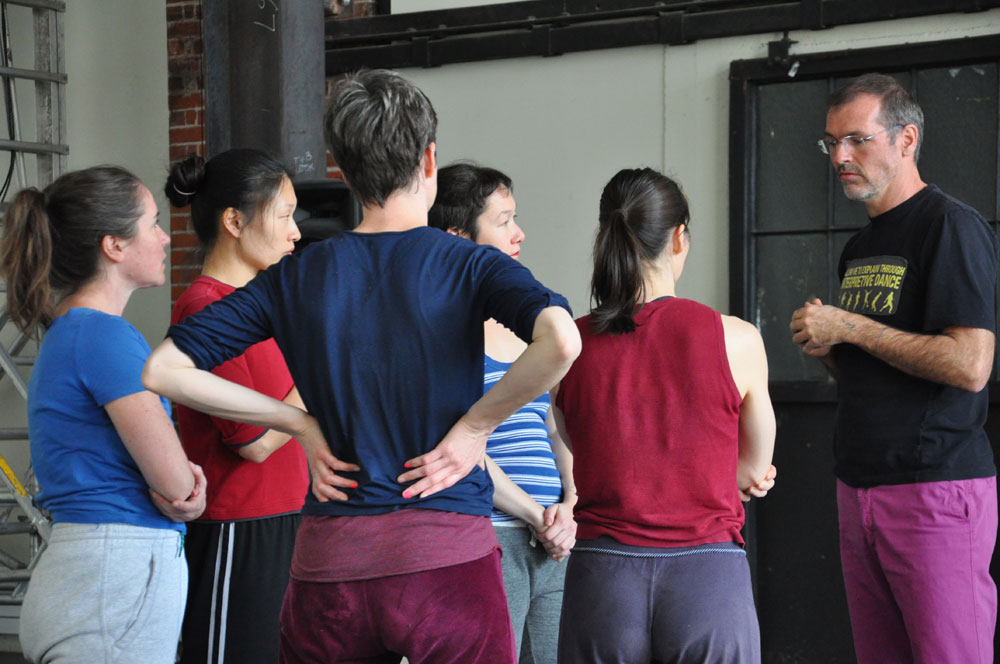
© Christy Funsch. (Click image for larger version)
Hennessy tells nonlinear stories through his interdisciplinary performances, and he reassembled Funsch’s out-of-context segment into a composed whole. He varied the pacing by speeding up the jogging steps and the side-to-side running, juxtaposing them with a Butoh-esque phrase of the women stock-still but for barely moving arms and torsos. He also used every sector of the studio, from corners to sides to back, and placed a sequence up against the front row of the audience. His wreck ended definitively, with the women line up downstage to perform Funsch’s quaking lunges, then walking offstage one by one.
After the Wrecking
This was not Funsch’s first Wrecking; she has applied the process many times when creating work.
Funsch also values open-studio Wrecking as a community service, a way to make contemporary dance more inviting and accessible. “I believe I am offering a rich opportunity to the wrecking choreographers,” Funsch wrote. “They are given the opportunity to flex their directing muscles quickly, with the edge of being witnessed as a motivator.”
The Wrecking process also showed Funsch to be an unpretentious dance maker, willing to test her work’s validity in front of an audience. It was fascinating to see the same phrases through different artists’ eyes, and remarkable how readily the movement took on different interpretations. If you wrecked a story ballet, you’d end up with a wreck (which could also be fun); in this case, nonsense may be the point – or maybe not. “I hope that I’m leading down a really specific path, and all of a sudden it branches,” Funsch told me. “It’s up to you to interpret what you just saw.” Just as it was up to the wreckers.
As for the audience, she told me during a rehearsal break, “They can see how choreographers make decisions and how the dancers navigate it, and their ability to embody the information and then let it go.” Indeed, the dancers’ skill at memorizing four versions of the same work was even more impressive than the choreographers’ ability to create them on the spot; that virtuosity pierces the anti-technique veneer put up by many postmodern dance artists.
Ultimately, this particular excerpt may not appear in the final Dissolver in any form, wrecked or not. “We may spend six weeks on [something], but now it’s gone. That kind of letting go is what we do all the time,” she said. And after spending four hours with Dissolver, I still don’t know what it’s about. But I’m comfortable letting that go. Die, die, my darlings.
To see videos of Funsch’s excerpt and the versions created at the Wrecking, visit https://vimeo.com/user3159757.






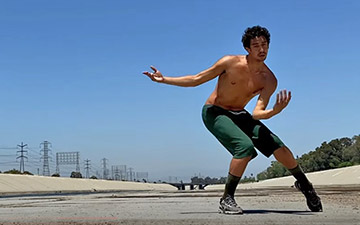
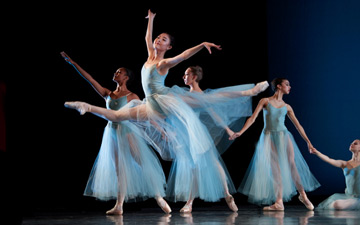





You must be logged in to post a comment.